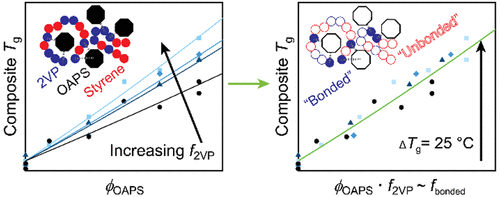当前位置:
X-MOL 学术
›
ACS Macro Lett.
›
论文详情
Our official English website, www.x-mol.net, welcomes your feedback! (Note: you will need to create a separate account there.)
Rationalizing the Composition Dependence of Glass Transition Temperatures in Amorphous Polymer/POSS Composites
ACS Macro Letters ( IF 5.8 ) Pub Date : 2021-10-20 , DOI: 10.1021/acsmacrolett.1c00597 Walter W Young 1 , Joseph P Saez 2 , Reika Katsumata 1
ACS Macro Letters ( IF 5.8 ) Pub Date : 2021-10-20 , DOI: 10.1021/acsmacrolett.1c00597 Walter W Young 1 , Joseph P Saez 2 , Reika Katsumata 1
Affiliation

|
We report that the fractions of “bonded” or “unbonded” monomers at a filler interface dictate the composition dependence of the glass transition temperatures (Tg) of polyhedral oligomeric silsesquioxane (POSS)-containing nanocomposites. Tg is arguably the single most important material property; however, predicting Tg in nanocomposites is often challenging because of confounding interfacial effects. To this end, we design a model nanocomposite to systematically study Tg of nanocomposites by leveraging the “all-interfacial” nature of ultrasmall POSS fillers loaded into random copolymers of styrene and 2-vinylpyridine (2VP). The amine-functionalized POSS forms hydrogen bonds only with 2VP, which behaves as a “bonded” monomer. The influence of copolymer composition and POSS loading on the Tg of this model composite is successfully explained by a Fox equation framework. This model also captures the Tg increase of other POSS-based polymer composites and potentially directs the future design of nanocomposite materials with tailored Tg.
中文翻译:

合理化非晶聚合物/POSS复合材料中玻璃化转变温度的成分依赖性
我们报告说,填料界面处“键合”或“未键合”单体的比例决定了含多面体低聚倍半硅氧烷 (POSS) 纳米复合材料的玻璃化转变温度 (Tg )的组成依赖性。T g可以说是最重要的材料特性。然而,由于混杂的界面效应,预测纳米复合材料中的T g通常具有挑战性。为此,我们设计了一个模型纳米复合材料来系统地研究T g通过利用加载到苯乙烯和 2-乙烯基吡啶 (2VP) 的无规共聚物中的超小 POSS 填料的“全界面”性质来制备纳米复合材料。胺官能化的 POSS 仅与 2VP 形成氢键,其表现为“键合”单体。Fox方程框架成功地解释了共聚物组成和POSS负载对该模型复合材料的T g的影响。该模型还捕捉了其他基于 POSS 的聚合物复合材料的T g增加,并可能指导未来设计具有定制T g的纳米复合材料。
更新日期:2021-11-16
中文翻译:

合理化非晶聚合物/POSS复合材料中玻璃化转变温度的成分依赖性
我们报告说,填料界面处“键合”或“未键合”单体的比例决定了含多面体低聚倍半硅氧烷 (POSS) 纳米复合材料的玻璃化转变温度 (Tg )的组成依赖性。T g可以说是最重要的材料特性。然而,由于混杂的界面效应,预测纳米复合材料中的T g通常具有挑战性。为此,我们设计了一个模型纳米复合材料来系统地研究T g通过利用加载到苯乙烯和 2-乙烯基吡啶 (2VP) 的无规共聚物中的超小 POSS 填料的“全界面”性质来制备纳米复合材料。胺官能化的 POSS 仅与 2VP 形成氢键,其表现为“键合”单体。Fox方程框架成功地解释了共聚物组成和POSS负载对该模型复合材料的T g的影响。该模型还捕捉了其他基于 POSS 的聚合物复合材料的T g增加,并可能指导未来设计具有定制T g的纳米复合材料。



























 京公网安备 11010802027423号
京公网安备 11010802027423号